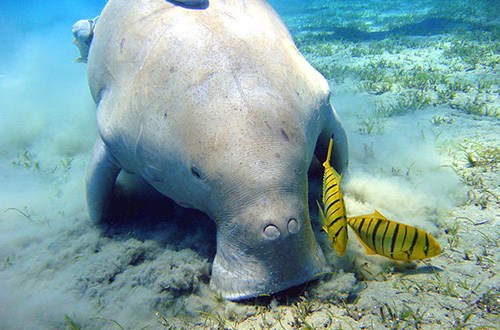Jakarta (Greeners) – Ministry of Marine Affairs and Fisheries issued national action plans for 20 priority marine endangered species for the next five years, said a senior official to Greeners, in Jakarta, on Thursday (23/06).
“The action plans were compiled by a team comprise of Indonesian Institute of Sciences, universities, civil societies, and other research institutes. In the future, the action plans would be integrated [to other agencies],” said Agus Darmawan, Secretary of Marine Spatial Planning Directorate General, Ministry of Marine Affairs and Fisheries.
READ ALSO: No Accurate Information on Indonesia’s Marine Ecosystem, Scientist Says
Currently, eleven species have been mapped out in the action plans, said Darmawan.
The species are whale, turtle, dolphin, and dugong. However, the latter is still uncertain for its population in Indonesia. Dermawan estimated 1,000 dugongs in the past decade in the country.
On dugong (Dugong dugon), he said that the species was listed as protected species of which its uses, such as meat or tears, were under the law. Exploitation rate by humans over the species, which locally known as ‘ikan duyung’, run faster than its ability to reproduce.
Dugongs can be found in Bintan, Toli-Toli district, Morowali district, Alor, North Sulawesi and West Kotawaringin.
Meanwhile, Wawan Kiswara, a researcher of Oceanography Research Center, said that dugong had already extinct since 1917 in Europe which was followed by diseases attacking seagrass, 13 years later. Seagrass was never grow again in the continent.
“If dugong is gone from our country, then seagrass would be destroyed along with its ecosystem. If seagrass destroyed, then sea cucumber and crab will also be extinct,” said Kiswara.
READ ALSO: In Indonesia, Protected Whale Shark Available for Tourists Under These Terms
Furthermore, he said that seagrass destruction would contribute to dugong extinction. Seagrass accounts for 31,000 square kilometer however LIPI data stated that only 25,752 hectares have been validated in 29 locations in Indonesia.
There is no clear data, distribution and population of dugong in Indonesia.
Darmawan said that follow up would not just stop at national action plan but it must also concentrated on road map of implementation.
“The road map will be the ministry’s work basis. It will be our working paper. I think it will need agreement from all related stakeholders to make this action plans to work,” he said.
Reports by Danny Kosasih



















































